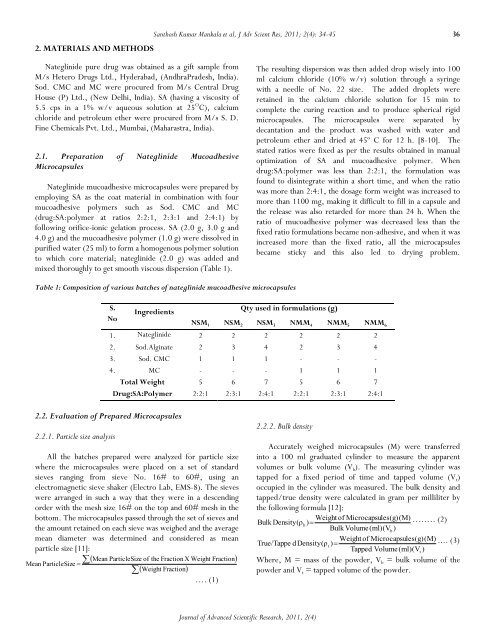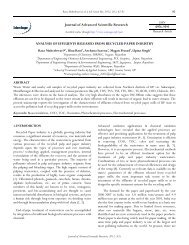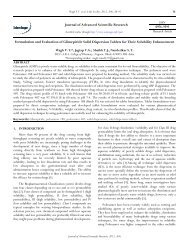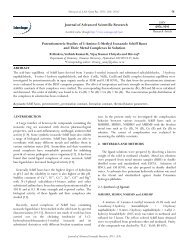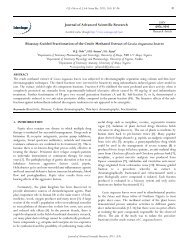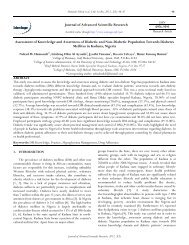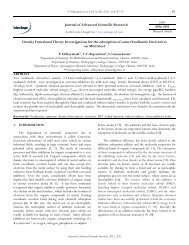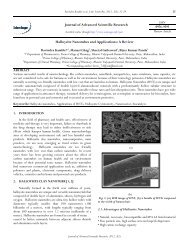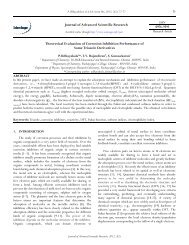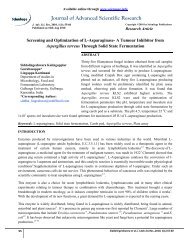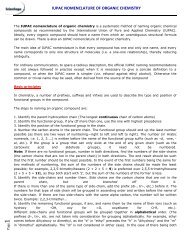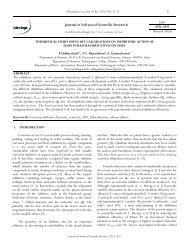Development and Characterization of ... - Sciensage.info
Development and Characterization of ... - Sciensage.info
Development and Characterization of ... - Sciensage.info
Create successful ePaper yourself
Turn your PDF publications into a flip-book with our unique Google optimized e-Paper software.
2. MATERIALS AND METHODS<br />
Santhosh Kumar Mankala et al, J Adv Scient Res, 2011; 2(4): 34-45 36<br />
Nateglinide pure drug was obtained as a gift sample from<br />
M/s Hetero Drugs Ltd., Hyderabad, (AndhraPradesh, India).<br />
Sod. CMC <strong>and</strong> MC were procured from M/s Central Drug<br />
House (P) Ltd., (New Delhi, India). SA (having a viscosity <strong>of</strong><br />
5.5 cps in a 1% w/v aqueous solution at 25 O C), calcium<br />
chloride <strong>and</strong> petroleum ether were procured from M/s S. D.<br />
Fine Chemicals Pvt. Ltd., Mumbai, (Maharastra, India).<br />
2.1. Preparation <strong>of</strong> Nateglinide Mucoadhesive<br />
Microcapsules<br />
Nateglinide mucoadhesive microcapsules were prepared by<br />
employing SA as the coat material in combination with four<br />
mucoadhesive polymers such as Sod. CMC <strong>and</strong> MC<br />
(drug:SA:polymer at ratios 2:2:1, 2:3:1 <strong>and</strong> 2:4:1) by<br />
following orifice-ionic gelation process. SA (2.0 g, 3.0 g <strong>and</strong><br />
4.0 g) <strong>and</strong> the mucoadhesive polymer (1.0 g) were dissolved in<br />
purified water (25 ml) to form a homogenous polymer solution<br />
to which core material; nateglinide (2.0 g) was added <strong>and</strong><br />
mixed thoroughly to get smooth viscous dispersion (Table 1).<br />
The resulting dispersion was then added drop wisely into 100<br />
ml calcium chloride (10% w/v) solution through a syringe<br />
with a needle <strong>of</strong> No. 22 size. The added droplets were<br />
retained in the calcium chloride solution for 15 min to<br />
complete the curing reaction <strong>and</strong> to produce spherical rigid<br />
microcapsules. The microcapsules were separated by<br />
decantation <strong>and</strong> the product was washed with water <strong>and</strong><br />
petroleum ether <strong>and</strong> dried at 45º C for 12 h. [8-10]. The<br />
stated ratios were fixed as per the results obtained in manual<br />
optimization <strong>of</strong> SA <strong>and</strong> mucoadhesive polymer. When<br />
drug:SA:polymer was less than 2:2:1, the formulation was<br />
found to disintegrate within a short time, <strong>and</strong> when the ratio<br />
was more than 2:4:1, the dosage form weight was increased to<br />
more than 1100 mg, making it difficult to fill in a capsule <strong>and</strong><br />
the release was also retarded for more than 24 h. When the<br />
ratio <strong>of</strong> mucoadhesive polymer was decreased less than the<br />
fixed ratio formulations became non-adhesive, <strong>and</strong> when it was<br />
increased more than the fixed ratio, all the microcapsules<br />
became sticky <strong>and</strong> this also led to drying problem.<br />
Table 1: Composition <strong>of</strong> various batches <strong>of</strong> nateglinide mucoadhesive microcapsules<br />
S.<br />
No<br />
Ingredients<br />
Qty used in formulations (g)<br />
NSM 1 NSM 2 NSM 3 NMM 4 NMM 5 NMM 6<br />
1. Nateglinide 2 2 2 2 2 2<br />
2. Sod.Alginate 2 3 4 2 3 4<br />
3. Sod. CMC 1 1 1 - - -<br />
4. MC - - - 1 1 1<br />
Total Weight 5 6 7 5 6 7<br />
Drug:SA:Polymer 2:2:1 2:3:1 2:4:1 2:2:1 2:3:1 2:4:1<br />
2.2. Evaluation <strong>of</strong> Prepared Microcapsules<br />
2.2.1. Particle size analysis<br />
All the batches prepared were analyzed for particle size<br />
where the microcapsules were placed on a set <strong>of</strong> st<strong>and</strong>ard<br />
sieves ranging from sieve No. 16# to 60#, using an<br />
electromagnetic sieve shaker (Electro Lab, EMS-8). The sieves<br />
were arranged in such a way that they were in a descending<br />
order with the mesh size 16# on the top <strong>and</strong> 60# mesh in the<br />
bottom. The microcapsules passed through the set <strong>of</strong> sieves <strong>and</strong><br />
the amount retained on each sieve was weighed <strong>and</strong> the average<br />
mean diameter was determined <strong>and</strong> considered as mean<br />
particle size [11]:<br />
Mean ParticleSize <strong>of</strong> the Fraction X Weight Fraction<br />
<br />
Weight Fraction<br />
…. (1)<br />
Mean ParticleSize<br />
2.2.2. Bulk density<br />
Accurately weighed microcapsules (M) were transferred<br />
into a 100 ml graduated cylinder to measure the apparent<br />
volumes or bulk volume (V b ). The measuring cylinder was<br />
tapped for a fixed period <strong>of</strong> time <strong>and</strong> tapped volume (V t )<br />
occupied in the cylinder was measured. The bulk density <strong>and</strong><br />
tapped/true density were calculated in gram per milliliter by<br />
the following formula [12]:<br />
Weight <strong>of</strong> Microcapsules(g)(M)<br />
Bulk Density(ρ<br />
b<br />
) ….…. (2)<br />
Bulk Volume(ml)(V<br />
b<br />
)<br />
Weight <strong>of</strong> Microcapsules(g)(M)<br />
True/Tappe dDensity(ρ<br />
t<br />
) .... (3)<br />
Tapped Volume(ml)(V<br />
t<br />
)<br />
Where, M = mass <strong>of</strong> the powder, V b = bulk volume <strong>of</strong> the<br />
powder <strong>and</strong> V t = tapped volume <strong>of</strong> the powder.<br />
Journal <strong>of</strong> Advanced Scientific Research, 2011, 2(4)


